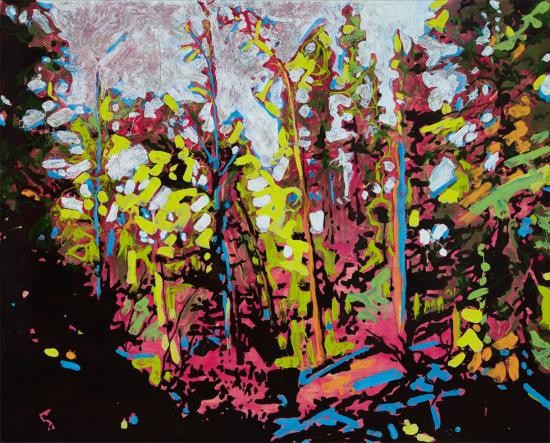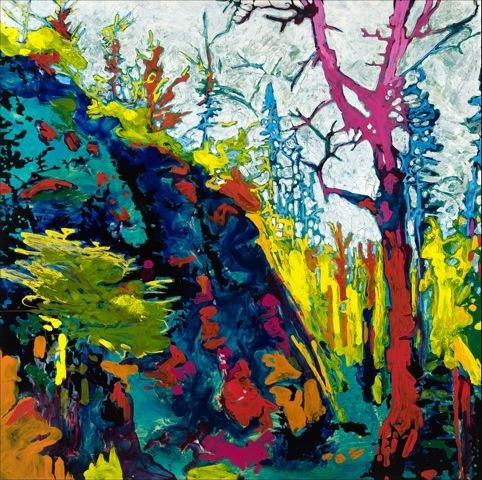Tara Bradbury, The Telegram
Growing up in Ontario, Steve Driscoll was perhaps not privy to the deceptive calmness of the ocean. Quiet one minute, roaring upon the rocks the next, the unpredictability of the water at its edge was a source of inspiration Driscoll wasn’t to experience until 2004, during his first visit to Pouch Cove.
The visual artist spent close to a month immersed in the local landscape, marveling in the power of the sea, often exploring by day; painting through the night.
“Upon my arrival in Pouch Cove, I was immediately drawn to the ocean and was fascinated by the steady yet unpredictable crashing of the waves,” Driscoll said.
At that point in his career, said Driscoll, now 30, he was already well into his work with his painting medium of choice — urethane — but was still experimenting with what it could do.
As it turns out, it was the perfect vehicle for him to capture the dance of the waves and their explosiveness as they collided with rocks.
“Urethane is fluid by nature, and the finished paintings retain this quality,” he explained.
While Driscoll was able to capture the water’s movement back then, he wasn’t quite able to express the explosion of water the way he wanted. Now, seven years on, he tried again, armed with photos taken during his first visit.
“Although I used photos to place the paintings, the crashing of the waves are mostly imagined or constructed through memory,” he said. “I set myself the task of capturing the vast and powerful pulse of the ocean, and the explosive rise of the water as the waves break.”
The result is “Dance of the Dories,” a 14-piece collection of urethane-on-panel artwork that will be shown at the James Baird Gallery in Pouch Cove from this Saturday until June 25.
Baird took a liking to Driscoll and his work when he first saw it in the studio space Driscoll shared with other painters in Toronto. At the time, Driscoll was represented by the same gallery as some of the more senior artists who had been to Baird’s Pouch Cove foundation, and Driscoll wanted to come to Newfoundland.
After the 2004 residency, Baird and Driscoll kept in touch. Driscoll has exhibited here a number of times since then, with shows in 2008, 2009 and 2010.
“Three years ago, Steve’s work took a more representative direction, and we joined forces to produce a 200-page monograph of his work, and organize exhibitions nationally and internationally,” Baird said.
Baird continues to be drawn to Driscoll’s work, calling him “the best thing since sliced bread” on his website.
“I’m a colourist; all the painters I represent and exhibit love to use vibrant colour in their work,” Baird said. “Steve is no exception, but more than that, he has developed a unique art practice in a medium that no one else uses: urethane. That material has properties unmatched by oils or acrylics, which is manifested in a physicality I adore.”
The use of urethane as a painting medium is very rare because its application is very toxic, Baird explained.
“Steve had learned over the past years to handle the material effectively, but during the learning curve, he has been able to explore the medium, working through many themes to find what is most successful for him and his art.”
Most of the current pieces show the explosive dance of water that enchanted Driscoll on his first visit here: there are waves upon waves, crashing into rocks and colliding next to boats, under calm skies and stormy skies, day and night. “Rolling Force” and “Blinding Spray” seem to be angrier pieces in colours unlike most of the others — blacks, purples, greens — while in “Eye of the Wave,” Driscoll’s urethane seems to gurgle beneath the foam of a crashing wave.
In “Morning Break,” drops and splashes of urethane depict perfectly the spray of the ocean in the air.
The only exceptions to the water dance are two paintings of buildings that drew Driscoll’s interest during his last visit here, last fall: Five Island Art Gallery in Tors Cove and an old shack he found on the drive between Pouch Cove and St. John’s.
“The windows of these buildings and the images captured in their reflections caught my eye,” Driscoll said. “Although the reflections are generally distorted, there is something inviting about them. As a viewer looking at the painting, you want to know what is inside the building, and what could be seen from inside, looking out.
“Specific location aside, I felt the wave-crashing images needed to be bracketed by a place where the viewer could be, so in this case, you might find yourself caught in a reflection, watching the waves.”
Baird says the images of Driscoll’s “Dance of the Dories” pieces don’t reproduce as well as his previous work, leading to a pleasant surprise when they actually arrived at the gallery.
“I was delighted to open the crates and be overwhelmed by the presence of the new paintings,” he said. “The view out my window in Pouch Cove is filled with ocean, but these works take the crashing waves and rough coastline in a new and wonderful direction.”
The public exhibition opening for Driscoll’s “Dance of the Dories” will take place at the James Baird Gallery, 654 Main Road in Pouch Cove, Saturday from 3-6 p.m.






